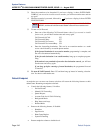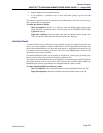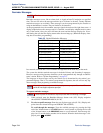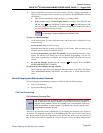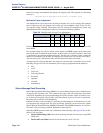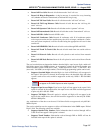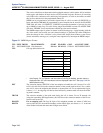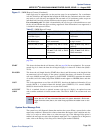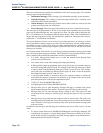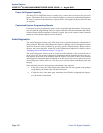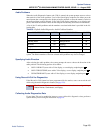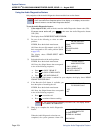
System Features
INTER-TEL
®
CS-5200/5400 ADMINISTRATOR GUIDE, ISSUE 1.1 – August 2005
Page 250 System Error/Message Print
The service technician may enable any combination of the error message types. The available
message types include the following:
• Information Messages: These messages give information regarding system operation.
• Warning Messages: The warnings in these messages indicate that a condition exists
which may affect system performance.
• Alarm Messages: Alarm messages indicate that a minor alarm has occurred, but that
general system operation was not affected.
• Severe Messages: These messages indicate that a severe error occurred in the system.
The messages can be programmed to be sent to any output device attached to the system. Mes-
sages can be printed through only one system port at a time. The print width is adjustable (64,
80, or 132 characters) to accommodate different output devices. When a line of information is
longer than the programmed width, the information is printed on subsequent lines and pre-
ceded with “+” to indicate the continuation.
The system database also has a reserved area for recording the history of messages to allow
service personnel to request a report at any time. The message history area has enough memory
to maintain a record of at least 50 of the most recently generated messages. When the reserved
area is full, the more recent messages begin to replace the older ones so that the most recent
messages are available.
In a network setting, each node has its own message print programming, message print output
port, and message print output port backup. There should be a message print terminal at each
node to monitor node and network performance and aid in troubleshooting.
• If a node’s Message Print output port is a node, the network sends Message Print
records to the specified node.
• You cannot select a node as the message print output port backup.
• If Message Print output programming forms a loop, the system will send the output to
the node’s backup Message Print port. For example, if the Message Print port on Node
1 routes to Node 2 and the Message Print port on Node 2 routes to Node 1, the configu-
ration will cause an infinite loop. Message Print reports for Node 1 would be printed to
the backup serial port on Node 2 and vice versa.
• A two digit node number is inserted in front of the sequence number to indicate the
node where the message originated. The following is an example of the new message
print string format for a message the originated on node 3:
• -03:001- 15:30 03-20 M6009 WRN EG CP
• Corrupted Queue Was Cleared: HISTORY QUEUE
• Message Print will not route diagnostic messages that apply to another node, except
during manual Message Print requests. Those messages will only be printed locally.
• Message Print will not route messages during a startup or reset. The system will wait
one minute before starting to send messages. Startup messages will only be printed
locally.
• Messages may not be printed in time sequence order on remote nodes. The order of an
incoming message print depends on how the message print was routed to the destination
node. Therefore, a message print could possibly arrive at the destination message print
node out of order.
In addition to the messages, the following error indications will occur in the event of a system
alarm:
• If a major system alarm occurs, MAJOR ALARM appears on all display endpoints. The
warning may also appear on a single display phone if the phone is defective. If all end-
points on the system are inoperative, the alarm message appears on the Administrator’s
display phone and the chassis LCD panel.



